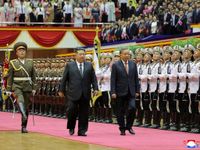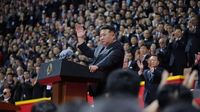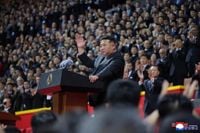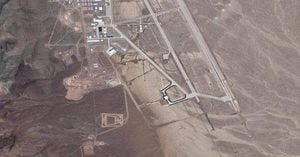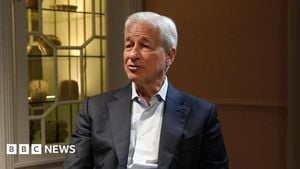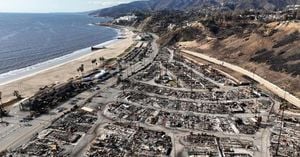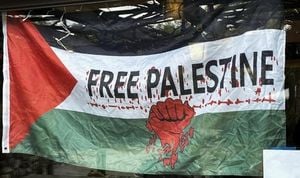On the evening of October 9, 2025, Pyongyang’s May Day Stadium was ablaze with color, spectacle, and political symbolism as North Korean leader Kim Jong Un delivered a rousing address to tens of thousands of spectators. The occasion: the 80th founding anniversary of the ruling Workers’ Party of Korea, a milestone that Kim used to both celebrate his country’s resilience and chart an ambitious course for its future. As fireworks illuminated the night sky and the stands erupted in choreographed displays, Kim’s message was clear—he would transform North Korea into “the best socialist paradise in the world.”
According to reports from AP and the official Korean Central News Agency (KCNA), Kim’s speech was more than a ceremonial flourish. It was a declaration of intent, delivered in the presence of prominent foreign dignitaries, including Chinese Premier Li Qiang, former Russian President Dmitry Medvedev, and Vietnamese Communist Party General Secretary To Lam. The event, which featured mass games, artistic performances, and a dazzling fireworks show, underscored North Korea’s determination to showcase its sovereignty and strength on the world stage—even as it remains largely isolated from Western nations.
Kim’s address was steeped in both historical reflection and forward-looking ambition. He acknowledged the enormous challenges North Korea has faced, particularly the delicate balancing act between economic development and nuclear weapons advancement, a dual track that dates back to the politically turbulent 1990s. “Historically, there has been no such country in the world as ours, which had to carry out so many tasks, both challenging and gigantic, for national defense and construction, even as it was facing constant and tenacious pressure, interference and threats of aggression by outside forces,” Kim stated, as reported by KCNA.
Despite what he described as ongoing “ferocious political and military” pressures from international adversaries, Kim asserted that North Korea’s “international prestige” as a dedicated socialist state continues to strengthen with each passing year. “Our party and government are still coping with our adversaries’ ferocious political and military moves of pressure by pursuing harder-line policies, holding fast to firm principles and employing brave, unflinching countermeasures,” Kim said, according to AP. “This is powerfully propelling the growth of the progressive camp against war and hegemony.”
Kim’s vision for the future was unambiguous. “I will surely turn this country into a more affluent and beautiful land and into the best socialist paradise in the world,” he declared, projecting optimism despite the country’s ongoing economic challenges and the weight of international sanctions. The state-run Rodong Sinmun and two other major newspapers echoed this sentiment in a rare joint editorial on October 9, urging unwavering loyalty to Kim and robust support for his nuclear weapons program. “Kim is the great representative of the Party and the nation’s dignity and bright future,” the editorial proclaimed, marking the first such joint message since January 2012, shortly after Kim assumed power.
Diplomatic engagement was a central theme of the anniversary celebrations. Kim met separately with Li Qiang and To Lam to discuss strengthening ties, while his deputy, Jo Yong Won, held talks with Medvedev. These meetings, coupled with the visible presence of foreign dignitaries at the festivities, signaled North Korea’s ongoing efforts to reinforce its partnerships with traditional allies such as China, Russia, and Vietnam—especially as relations with Western countries remain frosty.
The anniversary’s pinnacle was expected to be a grand military parade at a Pyongyang plaza, likely to occur later on October 10, after a day of rain. According to South Korean military assessments and satellite imagery, North Korea’s military parades have grown increasingly elaborate under Kim’s leadership, offering rare glimpses into the secretive nation’s advancing nuclear and missile programs. This year’s parade was anticipated to feature some of the country’s most advanced weapons, including intercontinental ballistic missiles (ICBMs) with the potential to reach the U.S. mainland and shorter-range systems targeting South Korea.
There was particular international interest in whether North Korea would unveil what it calls the “next-generation” Hwasong-20 ICBM, which reportedly boasts a solid-fuel engine tested just a month prior. Foreign experts believe this latest missile could be designed to carry multiple nuclear warheads, potentially capable of overcoming U.S. missile defense systems—a development that would further escalate tensions on the Korean Peninsula and beyond.
Kim’s pursuit of nuclear and military expansion has, in many ways, accelerated since the collapse of high-stakes nuclear diplomacy with former U.S. President Donald Trump in 2019. The talks broke down over disagreements regarding U.S.-led economic sanctions and North Korea’s denuclearization. Nevertheless, Kim has signaled a possible willingness to resume negotiations, provided the U.S. drops its demand for complete denuclearization. “Kim suggested he could return to talks if the U.S. drops its demand for a complete denuclearization of North Korea,” AP reported, referencing Kim’s remarks from September 2025.
Since Russia’s invasion of Ukraine, North Korea has prioritized its relationship with Moscow, sending thousands of troops and large shipments of conventional weapons to support Russia’s war effort. Kim’s recent diplomatic overtures have also included a high-profile visit to China, where he appeared alongside President Xi Jinping and Russian President Vladimir Putin at a massive military parade—a clear display of potential trilateral solidarity against the U.S. and its allies.
Despite the fanfare and optimism projected by North Korean state media, the country remains shrouded in secrecy. Its strict information blockade makes it nearly impossible for outsiders to independently verify internal developments. Foreign governments and intelligence agencies rely on satellite imagery and state media broadcasts—often delayed or heavily edited—to glean insights into the regime’s intentions and capabilities. As AP notes, “North Korea’s state TV sometimes conducts live broadcasts of military parades but more often airs recorded programs hours or even a day after they happened.”
For Kim Jong Un, the 80th anniversary of the Workers’ Party was an opportunity to reaffirm his leadership, rally the nation, and broadcast his vision to the world. Whether North Korea can overcome its formidable economic and diplomatic obstacles to realize Kim’s dream of a socialist paradise remains an open question. But for one night in Pyongyang, at least, the promise of a brighter future was on full display—fireworks, mass games, and all.
